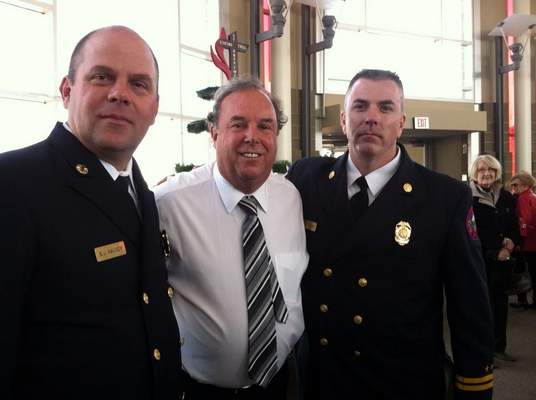By Michael Kelly Omaha World-Herald

Omaha Fire Chief Bernie Kanger, left, retired New York Battalion Chief Richard Picciotto and Omaha acting Assistant Fire Chief Dan Olsen.
On 9/11, as the North Tower of the World Trade Center began to fall, a firefighter descending a stairwell prayed, “Please, God, make it quick.”
With the world watching, the 110-story office tower did fall quickly — in eight incredibly loud and chaotic seconds. What Battalion Chief Richard Picciotto had prayed for, though, wasn’t a quick fall but rather a quick and painless death.
Instead, he and 13 others survived in the central stairway. As he told an Omaha audience this week, it took an hour and a half until another chief responded to Picciotto’s radio call that he and others were alive inside the North Tower.
“Richie, you can’t be in there,” his colleague said. “There is no North Tower.”
Several hours later, the dust-covered survivors emerged out of the top of the debris. Picciotto, then 51, was the first to reach daylight.
“All of a sudden, I’m out,” he said. “I’m on the biggest pile of debris in the whole debris field. What I saw was devastation. I thought there had been a nuclear bomb.”
Known in the Fire Department of New York as “Chief Pitch,” the retired Picciotto spoke to about 900 people, mostly women, Wednesday as part of the Omaha Town Hall lecture series.
His talk did have a chief pitch, which was that tragedy refocuses our priorities, that 9/11 brought the nation together and that politicians since have torn us apart.
After 9/11, he said, “It didn’t matter what we did (for a living), what church we went to or what color you were. We became united.”
Americans’ commonalities far outnumber our differences, he said, adding that, “Divisive politics has to go.”
Picciotto is the author of Last Man Down: A Firefighter’s Story of Survival and Escape from the World Trade Center, a New York Times best-seller that he said has been translated into 15 languages. He speaks about 15 times a year, a number that he says is dwindling.
He grew up in the blue-collar New York borough of Staten Island and spent much of his career working in Harlem and the Bronx. In 1993, he was a newly appointed battalion chief when terrorists set off bombs in the World Trade Center, and he took charge of evacuating the North Tower.
On September 11, 2001, he said, he knew as soon as the first plane flew into that tower that it was another terrorist attack. He soon arrived, saw the horror of people jumping and had walked up to the 35th floor when he heard a horrible rumble — the fall of the South Tower.
At that point, he ordered everyone who could get out to leave the North Tower.
“As firemen,” he said, “we take calculated risks. Not unnecessary or foolish risks. My training told me to get out of this building.”
On the way down, he and other firefighters would leave the stairway to check offices. Picciotto found a man working on his computer on the 27th floor, saying he needed to finish something important. The chief ordered him forcibly to the stairwell.
On the 12th floor, he came across people on crutches and in wheelchairs. Firefighters helped them to the stairs.
When Picciotto got between the seventh and sixth floors, he felt the North Tower begin to rumble and fall, “pancaking” from above with, he knew, a great loss of humanity.
When everything stopped, it was pitch black. Hours later, the dust had cleared enough that they saw faint light from above and clambered upward.
It was later determined that the 14 people inside the central “Stairway B” (12 of them firefighters) had been spared in part because they were in a structurally unique location.
The reinforced seventh floor, above a six-floor open atrium, apparently had served as a kind of helmet, diverting the falling debris just enough to protect the stairway.
During his talk at St. Andrew United Methodist Church, 150th Street and West Maple Road, Picciotto showed photos of the South Tower fireball when the second plane struck. He showed the dust cloud and other images from 9/11, including — for a moment — a photo of a man falling. It has been estimated that as many as 200 people either jumped or fell to their deaths.
Picciotto, married and the father of two adult children, said in an interview that he once was asked not to show the “falling man” photo. But he includes it “so people are reminded of how horrendous this was and how the threat (of terrorism) is still there.”
The audience included several Omaha firefighters, including Chief Bernie Kanger and Dan Olsen, acting assistant chief. Noting the bond of the profession, Picciotto called them “my brothers.”
Of the nearly 3,000 who died on 9/11 in New York, at the Pentagon and in the plane crash in Pennsylvania, 343 were members of FDNY.
Chief Pitch, who thanked those attending his talk for their support of New Yorkers and others after the terror, noted again that he had prayed for a quick death.
He is grateful, he said, that his prayer went unanswered.

